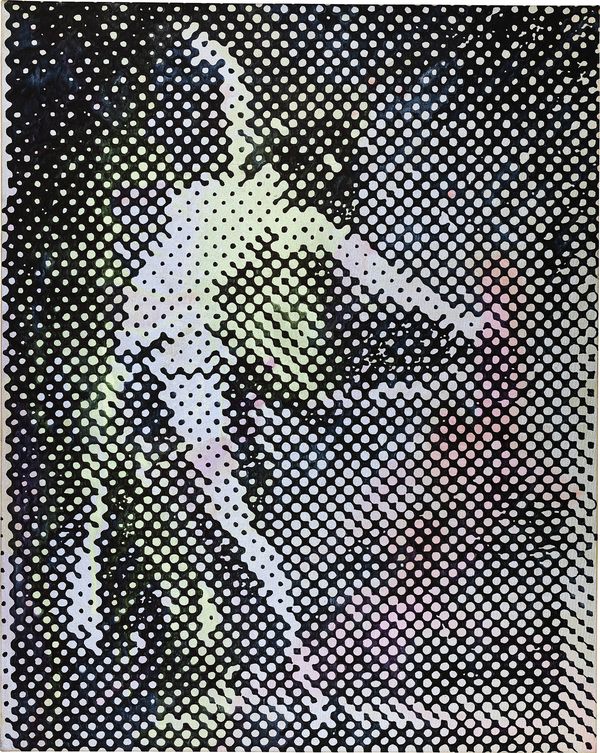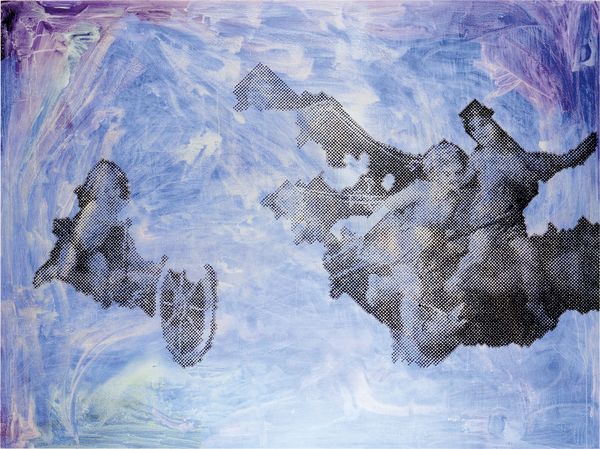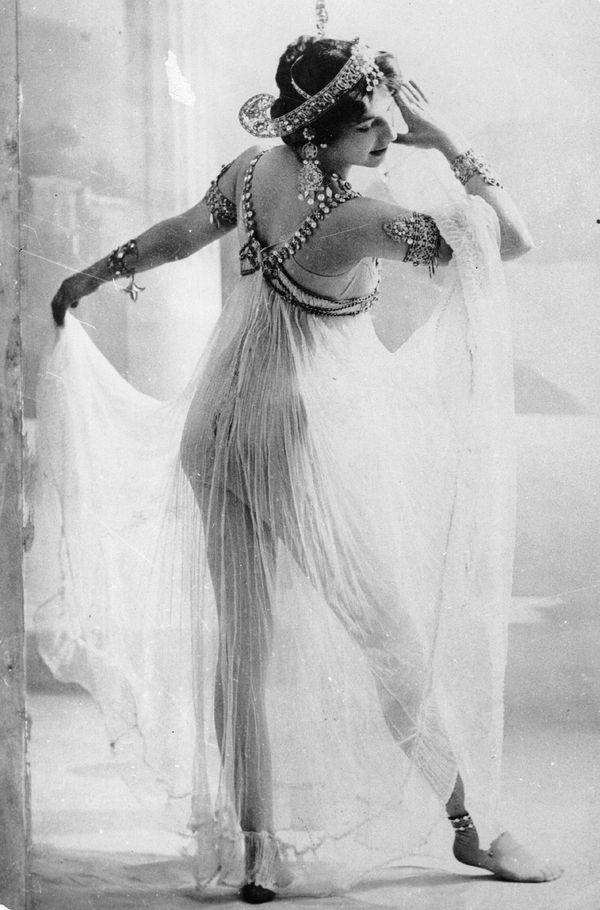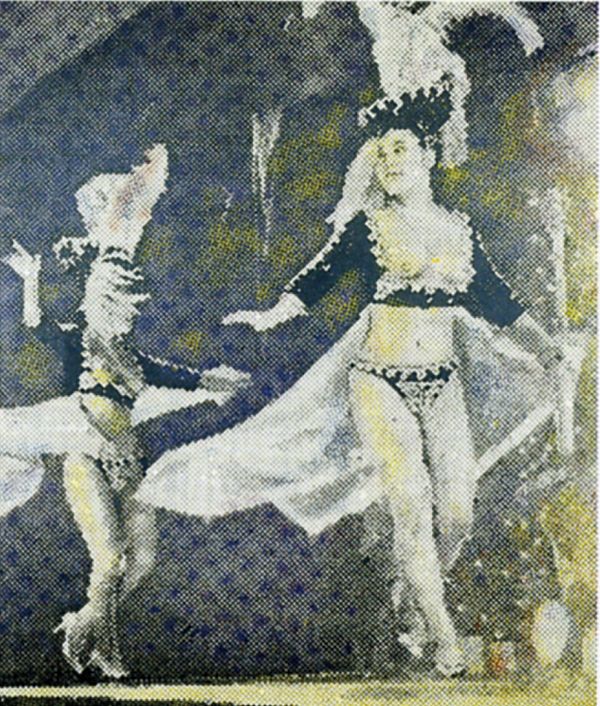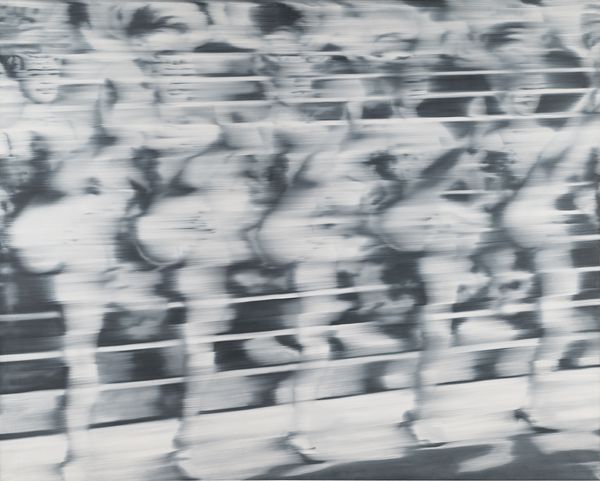Sigmar Polke Tänzerin, 1994
Oscillating in color and playful in her elegance, evoking the graceful movement of a dancer, Tänzerin (Dancer) is an exceptional example of Sigmar Polke's celebrated Rasterbilder (Raster paintings). Emblematic of the artist's mastery of alchemy and experimentation with optical effects, Tänzerin serves as a rare and magisterial synthesis of Polke's artistic explorations. At the locus of his experiments with alchemy, this exceptional work has remained within a private German collection since its execution in 1994 and has never before been seen outside this setting. Exemplary of Polke's extensive analysis of aesthetics through materials and investigation into social and cultural models, the piece is a mirage of the artist's creativity.
Tänzerin is an exceptional rarity in Polke's use of his most celebrated and iconic earlier technique of the hand-painted Raster and his prolific experimentations with color. The artist was trained as a stained glass worker in his youth and remained fascinated by transparency, translucency and the effects of light on perception. Here, his use of interference color is exemplary of his continued experimentation with chemicals and perfected technique of rigorously hand-painted specs.
Phillips Chairman Cheyenne Westphal discusses the genesis of Polke's Tänzerin, his use of the Raster technique and the artist's experimentations with color.
Tänzerin, which embodies how Polke transcends the distinction between the abstract and the figurative, is rare amidst his creative output of the 1990s. The elegant dancer emerges through a web of pointillism that imbues expressive force into the composition. Viewed within the context of other partial Raster paintings from the period, Kleiner Mann (Small Man), 1986-1992 (Museum Frieder Burda, Baden-Baden) and Grosser Mann (Large Man), 1986-1992 (Museum Frieder Burda, Baden-Baden), Tänzerin is elevated and refined, the dancer emerging through a fabric of dots spanning the complete picture plane.
Sigmar Polke Putti (Sie erleben heute im privaten Bereich zahlreiche Glucksmomente) (Putti (You Experience Countless Moments of Joy in Your Private Life Today)), 2007. Private Collection, Germany © The Estate of Sigmar Polke, Cologne, DACS 2017
Polke became an alchemist of sorts, exploring color through the 1970s, '80s and '90s by mixing new materials and pigments. Culminating in Athanor, the artist's project for the Pavilion of the Federal Republic of Germany during the Venice Biennale of 1986 (for which he was awarded the Golden Lion Grand Prize for Painting), Polke's fascination with alchemy was highlighted alongside his concern for manipulating and deconstructing imagery. Epitomizing his distinguished use of chemistry and Raster, Athanor explored the variable and erratic effects of color, temperature, light and tone in a new collection of forms.
Spots, drips, coatings and emulsions fused together, inviting the viewer to explore the picture plane and trace the outline of Polke's subject matter. Here, another seemingly monochromatic Raster painting, Polizeischwein (Police Pig), 1986, was exhibited alongside other works presenting his mastery of alchemy. Set against the chemical experiments of other works, Polizeischwein demonstrated the artist's continued concern with reproducing his 'Rastered' photographic weave. Harnessing these experimentations, expertly synthesizing his early technique with the visual alchemy of tone, Tänzerin transports the viewer to the very origin of Polke's successful and internationally celebrated style. The iridescent surface of the picture oscillates under light and motion, the movement of the onlooker revealing changes in chromaticity, reflecting Polke's hallucinogenic universe. Dot by dot, the metallic paint reveals the fluid nature of the composition from which the dancer materializes, the tonality of the metallic background preventing the work from becoming a static composition.
Mata Hari performing the Dance of the Seven Veils, 1906
Dignified and effortless, the central figure recalls a long tradition of dance in the canon of twentieth-century painting. Primary to the influential theories of Jean-Georges Noverre (1727-1810), the personality of dance is deemed a prerequisite to artistic development. Drawing on this history of the close correlation between dancing and painting, Polke brings the figure into a contemporary setting and places it at the center of the composition. His figure in this Evening Sale work is reminiscent of a thinly veiled Mata Hari. In fact, Polke revisited this theme of the dancer throughout his oeuvre, in particular when he portrayed playful circus environments.
An early rendering of the subject matter, Japanische Tänzerinnen (Japanese Dancers), 1966 presents an initial assessment of figures through the artist's Raster technique. Returning to his fabric of dots, later works such as Untitled, 2004 and Putti (Sie erleben heute im privaten Bereich zahlreiche Glücksmomente) (Putti (You Experience Countless Moments of Joy in Your Private Life Today)), 2007, with their iridescent surfaces and experimental engagement with color, display the artist’s preoccupation with the systematic Raster technique that we find so powerfully and fastidiously represented in Tänzerin from 1994.
I like the way that the dots in a magnified picture swim and move about. The way that motifs change from recognizable to unrecognizable, the undecided, ambiguous nature of the situation, the way it remains open.
— Sigmar Polke
Sigmar Polke Japanische Tänzerinnen (Japanese Dancers), 1966. Private Collection © The Estate of Sigmar Polke, Cologne, DACS 2017
With Tänzerin, Polke completed a return to a 1960s technique of rendering his detailed scrim of dots by hand. Together with his fellow Capitalist Realists, Polke became increasingly concerned with the rejection of the ubiquitous art of the time and occupied with the depiction of daily commodities, each artist engaging with a media-rich approach and the utilization of fragmented images. In a similar vein to American Pop Art, the Capitalist Realists cast aside symbolic modes of communication and focused on the trifles of life. Bringing his Raster dots to the fore, Polke sought to expose the false reality of the commercial focus of popular culture. Addressing the notion of desire within consumerism, Polke masterfully alters the source images through the calculated use of Raster dots each varying in scale and configuration. Framed within an apparent white border, the appropriated nature of the source image in Tänzerin is brought to the fore, the artist's deconstruction of commercial imagery and desirable norms confirmed.
In the same way, Polke's Pop contemporary, Roy Lichtenstein, used 'benday dots' to compose enlarged and painterly depiction of popular imagery. In direct contrast however, Lichtenstein’s 'benday dots' form the ground of his subject matter, whereas Polke masterfully traces the imagery in the dots itself. Escaping the exultant neatly distinct imagery of Lichtenstein, Polke experimented with a range of density, sizes and tones in his pixels. Acutely aware of commercial advertising material and the increasingly commoditized notion of desire, Polke highlights how "he dots in a magnified picture swim and move about. The way that motifs change from recognizable to unrecognizable, the undecided, ambiguous nature of the situation, the way it remains open..,Nothing is so effective as Raster pictures when it comes to destroying the naive acceptance of technical pictures as depicting 'things from the world on a flat surface,'" as the artist himself was quoted in a 1997 exhibition catalogue for Bonn, Germany. Both artists harness the power of compositional elements, forging new pockets of abstraction within their own realm. Carefully tracing the dancer through varied shades of ink, no dot the same, the artist engrosses the viewer in an unexpected motion, our perception tracing the moving outline of the graceful figure as the epitome of desire.
This captivating dancer is distinct from Polke's less glamorous depictions of the conflicting factors moulding the German post-war experience; Tänzerin is innocently graceful and freed from connotations with the former DDR (Deutsche Demokratische Republik). Bitingly dissecting consumer society, many of Polke's borrowed source images are unequivocally figurative. The work entices the viewer, with its dancing figure appearing mirage-like from a metallic ground while simultaneously being out-of-reach, veiled underneath Polke's distinctive network of patterned dots.
Gerhard Richter Tänzerinnen (Ballet Dancers), 1966. Private Collection © Gerhard Richter 2017
Surrounded by the ingenuity and discourse of fellow co-founders of the Capitalist Realist movement, namely Konrad Lueg (later Konrad Fischer), Gerhard Richter, Manfred Kuttner, Joseph Beuys and the artists of the confrontational Fluxus movement, Polke was immersed and actively engaged in the tendency for questioning cultural norms and exploring provocative narratives. In the early 1960s, Polke established his iconic style that spanned his five-decade long career, challenging artistic notions from an early stage in his career. It was within this context that the artist began creating his Raster paintings. Throughout his prolific and innovative career he developed and refined this style, elevating half-tone Raster printing, typically used in advertising, newspapers and magazines, to a painterly artistic technique. Reflecting his and his fellow Capitalist Realist painters' early fundamental critique of mass media culture in the 1960s, the Raster paintings deconstruct the principle mode of illustrating reality: photography.
Distinct from other later examples, the entire surface of Tänzerin is composed in the Raster technique. This rarity paired with Polke's mastery of alchemy and exploration of abstraction and figuration makes Tänzerin exquisitely enchanting and visually arresting. A magisterial synthesis of the artist's command of chemical effects, conjuring of figurative motifs and hand-finished scrim of dots, the work celebrates the essence of Polke's artistic output.
Never before seen outside its domestic setting, this piece, in its graceful assertiveness, is homage to the gravitas of the artist's monumental and internationally acclaimed realizations.
